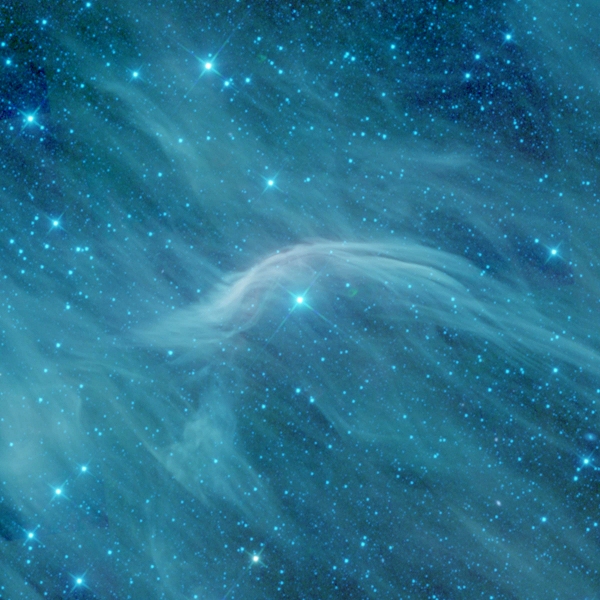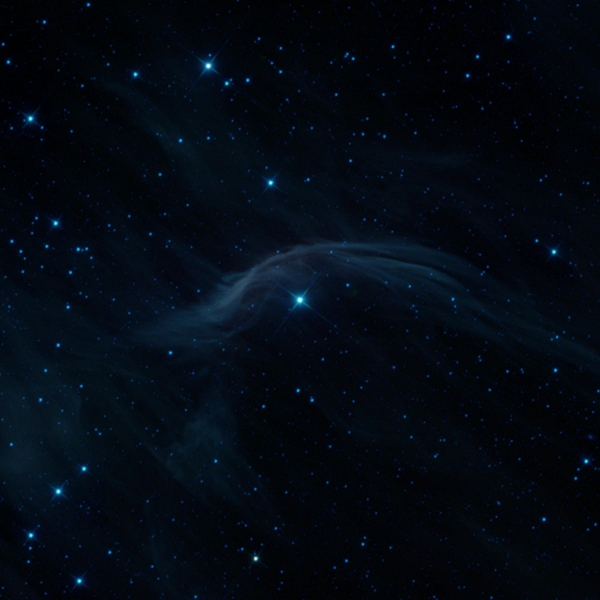It looks like you're using an Ad Blocker.
Please white-list or disable AboveTopSecret.com in your ad-blocking tool.
Thank you.
Some features of ATS will be disabled while you continue to use an ad-blocker.
5
share:
hi all
some cool pics I thought you all might like
www.newscientist.com...


some cool pics I thought you all might like
www.newscientist.com...
NOW that's one groovy star. Seen speeding like a bullet through a cloud of dust and gas, the massive star Zeta Ophiuchi is creating a colourful wave known as a bow shock. This happens because the star's motion is compressing dust grains like water at the bow of a ship.
To the naked eye Zeta Ophiuchi is a placid dot parked in the constellation Ophiuchus. But the infrared vision of NASA's Spitzer Space Telescope shows how the shooting star is electrifying its surroundings. It creates a scene akin to a UV-triggered fluorescent blacklight poster, says Spitzer image specialist Robert Hurt of the Jet Propulsion Laboratory in Pasadena, California.


edit on 21-1-2013 by goou111 because: (no reason given)
edit on 21-1-2013 by goou111 because: (no reason given)
Looking at the pictures reminds me of the nexus in Star Trek Generations. Pretty cool.
Stunning. s&f
I thought about posting this when I saw pictures of it on Hubble a few days ago (I think it was hubble) but didn't have time to throw a thread together. I'm glad someone posted it.
I thought about posting this when I saw pictures of it on Hubble a few days ago (I think it was hubble) but didn't have time to throw a thread together. I'm glad someone posted it.
What makes this star move so fast?
Does anyone know?
Oh, it's ok I found it
wow
Does anyone know?
Oh, it's ok I found it
Given its speed and direction, astronomers think the star once orbited an even heftier companion. But the biggest stars live fast and die young, and its partner exploded in a violent supernova blast that sent Zeta Ophiuchi careening away at a whopping 87,000 kilometres per hour.
wow
edit on 21-1-2013 by LeLeu because: (no reason given)
Originally posted by LeLeu
What makes this star move so fast?
Does anyone know?
Oh, it's ok I found it
Given its speed and direction, astronomers think the star once orbited an even heftier companion. But the biggest stars live fast and die young, and its partner exploded in a violent supernova blast that sent Zeta Ophiuchi careening away at a whopping 87,000 kilometres per hour.
wowedit on 21-1-2013 by LeLeu because: (no reason given)
Good question..
...and answer
edit on 21-1-2013 by goou111 because: (no reason given)
And yet its so damn hard to get a descent pictures of planets in our own galaxy
Originally posted by Senduko
And yet its so damn hard to get a descent pictures of planets in our own galaxy
It's all about angular resolution. Those two images span approximately 1 degree. For comparison, the full moon is 0.5 degrees across. So what you see in those images is huge. If you had infrared vision you would see this thing in the sky with your own eyes.
Here's a few images I created using WISE telescope data at skyview.gsfc.nasa.gov...
The images span 1 degree across.
22 / 12 / 4.6 microns

12 / 4.6 / 3.4 microns

Same as above but different brightness scaling

22 / 4.6 / 3.4 microns - similar to the published WISE image

edit on 21-1-2013 by wildespace because: (no reason given)
This beautiful star is in today's Astronomy Picture Of the Day (APOD): apod.nasa.gov...

I want to repeat my earlier comment here that the full moon is approximately 0.5 degrees across, so this image is quite large in comparison. If we had infrared vision (and strong sensitivity to it) like the Spitzer telescope, we would see this scene clearly with the naked eye.
What would be really cool is to take images 10 years apart and compare them, to catch any movement of the star or the bow-shock across that time frame.

Like a ship plowing through cosmic seas, runaway star Zeta Ophiuchi produces the arcing interstellar bow wave or bow shock seen in this stunning infrared portrait. In the false-color view, bluish Zeta Oph, a star about 20 times more massive than the Sun, lies near the center of the frame, moving toward the left at 24 kilometers per second. Its strong stellar wind precedes it, compressing and heating the dusty interstellar material and shaping the curved shock front. Around it are clouds of relatively undisturbed material. What set this star in motion? Zeta Oph was likely once a member of a binary star system, its companion star was more massive and hence shorter lived. When the companion exploded as a supernova catastrophically losing mass, Zeta Oph was flung out of the system. About 460 light-years away, Zeta Oph is 65,000 times more luminous than the Sun and would be one of the brighter stars in the sky if it weren't surrounded by obscuring dust. The image spans about 1.5 degrees or 12 light-years at the estimated distance of Zeta Ophiuchi.
I want to repeat my earlier comment here that the full moon is approximately 0.5 degrees across, so this image is quite large in comparison. If we had infrared vision (and strong sensitivity to it) like the Spitzer telescope, we would see this scene clearly with the naked eye.
What would be really cool is to take images 10 years apart and compare them, to catch any movement of the star or the bow-shock across that time frame.
new topics
-
VERY IMPORTANT..............
2024 Elections: 25 minutes ago -
Biden--My Uncle Was Eaten By Cannibals
US Political Madness: 32 minutes ago -
"We're All Hamas" Heard at Columbia University Protests
Social Issues and Civil Unrest: 33 minutes ago -
The good, the Bad and the Ugly!
Diseases and Pandemics: 2 hours ago -
Russian intelligence officer: explosions at defense factories in the USA and Wales may be sabotage
Weaponry: 4 hours ago -
African "Newcomers" Tell NYC They Don't Like the Free Food or Shelter They've Been Given
Social Issues and Civil Unrest: 5 hours ago -
Russia Flooding
Other Current Events: 7 hours ago -
MULTIPLE SKYMASTER MESSAGES GOING OUT
World War Three: 7 hours ago -
Two Serious Crimes Committed by President JOE BIDEN that are Easy to Impeach Him For.
US Political Madness: 8 hours ago -
911 emergency lines are DOWN across multiple states
Breaking Alternative News: 8 hours ago
top topics
-
Go Woke, Go Broke--Forbes Confirms Disney Has Lost Money On Star Wars
Movies: 15 hours ago, 13 flags -
Pro Hamas protesters at Columbia claim hit with chemical spray
World War Three: 11 hours ago, 11 flags -
Elites disapearing
Political Conspiracies: 13 hours ago, 9 flags -
African "Newcomers" Tell NYC They Don't Like the Free Food or Shelter They've Been Given
Social Issues and Civil Unrest: 5 hours ago, 8 flags -
Freddie Mercury
Paranormal Studies: 15 hours ago, 7 flags -
911 emergency lines are DOWN across multiple states
Breaking Alternative News: 8 hours ago, 6 flags -
Biden--My Uncle Was Eaten By Cannibals
US Political Madness: 32 minutes ago, 5 flags -
Two Serious Crimes Committed by President JOE BIDEN that are Easy to Impeach Him For.
US Political Madness: 8 hours ago, 5 flags -
A Personal Cigar UFO/UAP Video footage I have held onto and will release it here and now.
Aliens and UFOs: 13 hours ago, 5 flags -
Former NYT Reporter Attacks Scientists For Misleading Him Over COVID Lab-Leak Theory
Education and Media: 10 hours ago, 4 flags
active topics
-
Russian intelligence officer: explosions at defense factories in the USA and Wales may be sabotage
Weaponry • 110 • : RussianTroll -
African "Newcomers" Tell NYC They Don't Like the Free Food or Shelter They've Been Given
Social Issues and Civil Unrest • 10 • : marg6043 -
Biden--My Uncle Was Eaten By Cannibals
US Political Madness • 7 • : Encia22 -
Joe Biden and Donald Trump are both traitors
2024 Elections • 62 • : Xtrozero -
VERY IMPORTANT..............
2024 Elections • 4 • : Degradation33 -
Nirvana - Immigrant Song
Music • 8 • : PHYSIC2X -
Go Woke, Go Broke--Forbes Confirms Disney Has Lost Money On Star Wars
Movies • 17 • : PHYSIC2X -
A Personal Cigar UFO/UAP Video footage I have held onto and will release it here and now.
Aliens and UFOs • 11 • : PHYSIC2X -
Elites disapearing
Political Conspiracies • 24 • : PHYSIC2X -
Pro Hamas protesters at Columbia claim hit with chemical spray
World War Three • 13 • : PHYSIC2X
5
